U.S. Department of Transportation
Federal Highway Administration
1200 New Jersey Avenue, SE
Washington, DC 20590
202-366-4000
Federal Highway Administration Research and Technology
Coordinating, Developing, and Delivering Highway Transportation Innovations
|
R&T NOW This newsletter is an archived publication and may contain dated technical, contact, and link information. |
|
| Publication Number: N/A Date: July/August 2016 |
Publication Date: July/August 2016
|
PDF files can be viewed with the Acrobat® Reader®
Turner-Fairbank Hosts Students for Transportation Summer Mini-Camp
Nearly twenty young high school and college students attended the third annual Transportation Summer Mini-Camp at the Turner-Fairbank Highway Research Center (TFHRC) from June 28 – June 30, 2016.
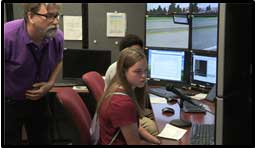 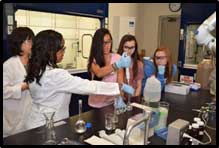 |
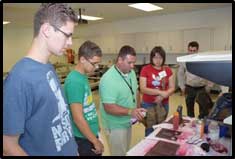 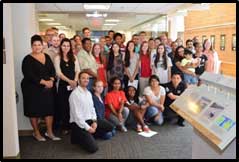 |
This year’s participants learned about transportation research in the areas of safety, operations, and infrastructure through discussions with staff and learned first-hand how science, technology, engineering, and mathematics (STEM) is applied through hands-on activities in several TFHRC laboratories.
New to this third annual Mini-camp is the “Literature Review Challenge” in which student teams will be assigned a research question and a coach, conduct a research literature search, review and organize the information they discovered, and prepare presentations to be given at the end of the camp.
For more information on the mini camp, please contact David Yang, david.yang@dot.gov, 202-493-3284.
FHWA Meets with TRB Executives
On June 22 and 23, 2016, Michael Trentacoste, FHWA’s Associate Administrator for Research, Development, and Technology, and Tim Schmidt, a Senior Advisor at Turner-Fairbank Highway Research Center (TFHRC), attended the Transportation Research Board (TRB) Executive Committee meeting, held in Irvine, California. FHWA Executive Director Butch Waidelich also participated in the conference via teleconference on June 23, 2016.
The meeting focused on agenda items that will help determine what role TRB should have in the future regarding cyber security trends and vulnerabilities; enhancing TRB’s engagement in freight issues; understanding the impacts of transformational technologies; and establishing a partnership between TRB and the National Academies Health and Medical Division to understand and promote links between transportation and public health.
The TRB Executive Committee serves as an advisory group to the chairman and the governing board of the National Research Council. The FHWA Administrator, other U.S. Department of Transportation (USDOT) modal administrators, and other sponsors serve as ex officio members. Members represent a balance of transportation modes, academic disciplines, private and public sectors, echelons of government, geographical regions, and other relevant factors.
For more information, contact Jack Jernigan, 202-493-3363, jack.jernigan@dot.gov.
Hydraulics Lab Spotlighted in Secretary Foxx’s Fast Lane Blog
USDOT Chief Innovation Officer Chris Gerdes posted an article on U.S. Transportation Secretary Anthony Foxx’s Fast Lane #TechTuesday blog. The article highlighted the innovative research being conducted in FHWA’s J. Sterling Jones Hydraulics Laboratory at Turner-Fairbank Highway Research Center. The lab has “all sorts of amazing things,” Gerdes observes, “a 90 feet long man-made water channel that can simulate an artificial river, laser scanners, robots and ultrasonic velocity probes—all coordinated to showcase bridge design of the future.” The article also explains the workings of an in-situ scour testing device, which is expected to help in assessing soil erosion resistance at bridge foundation sites and improve hydraulic design decisions.
The article is available at https://www.transportation.gov/fastlane/techtuesday-building-bridges-ground.
For more information, contact Kornel Kerenyi, kornel.kerenyi@dot.gov, 202-493-3142.
Deputy USDOT Secretary Dedicates FAST NDE Lab at Turner-Fairbank
On May 31, 2016, USDOT Deputy Secretary Victor Mendez dedicated FHWA’s new Non-Destructive Evaluation (NDE) Laboratory at TFHRC. The new lab—named the FHWA Advanced Sensing Technology (FAST) NDE Laboratory—has undergone a major refurbishment to meet FHWA and stakeholder needs in the 21st century.
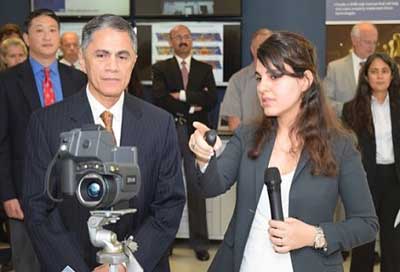 |
| TFHRC NDE Program Manager Hoda Azari demonstrates an infrared-sensitive camera to Deputy USDOT Secretary Victor Mendez. |
Renovations include developing customized, semi-automated, and automated NDE tools and robotic platforms; implementing physics-based modeling and numerical simulation; and improving data analysis approaches to give more actionable information to infrastructure owners and managers.
The original NDE Lab was established in 1998 to centralize and better coordinate research related to improving the state of the art and research and practice related to nondestructive testing. Through the NDE program and work conducted in its new FAST NDE Laboratory, FHWA will continue to play a leading role in developing new tools and evaluating emerging NDE technologies while demonstrating the value of technology to owners and decisionmakers.
For more information, contact Hoda Azari, 202-493-3064, hoda.azari@dot.gov.
FHWA Attends White House Conference on Resilient Building
On May 10, 2016, Sheila Duwadi, who heads FHWA’s Hazard Mitigation Team in its Office of Infrastructure Research and Development at the TFHRC, attended a White House Conference on Resilient Building Codes. The invitation came from the White House National Security Council Staff, the National Economic Council, the Office of Science and Technology Policy, the Council on Environmental Quality, and the Office of Management and Budget.
The event, which coincided with National Building Safety Month, took place at the Eisenhower Executive Office Building and brought together participants from the private and public sector to discuss resilience of the built environment and the critical role effective codes and standards play. Participants also discussed impacts of climate change and extreme events on the built environment.
For more information, contact Sheila Duwadi, 202-493-3106, sheila.duwadi@dot.gov.
FHWA Supports Smart Work Zone Demonstration
On June 23, 2016, FHWA’s Office of Operations Research and Development supported the demonstration of a Connected Vehicle Smart Work Zone application funded under its Small Business Innovative Research Program. The demonstration took place in an active work zone along the Dulles Access Road in northern Virginia and was coordinated with FHWA’s Virginia Division, the Virginia Department of Transportation (VDOT) Research, VDOT Work Zone and Operations, VDOT Northern Virginia, and the Dulles Metro Authority.
The Smart Work Zone system is to be deployed at work zones on freeways and major arterials. As drivers approach the work zone, the system informs them about work zone conditions, such as the number of lanes closed, estimated travel time through the work zone, and other conditions. The system also has the capability to detect the starting location of the congestion or queue backup and can relay that information beyond the queue backup using a novel hopping pattern. In addition, the backend system can collect traffic performance metrics for analysis and decisionmaking in real time. The system makes use of a combination of dedicated short-range communications and cellular technologies to interface with its various components.
For more information, contact Taylor Lochrane, 202-493-3293, taylor.lochrane@dot.gov.
FHWA Delivers Instrumented Vehicle to the Volpe Center
On May 13, 2016, research engineers from FHWA’s Office of Operations Research and Development visited the Volpe Center in Cambridge, MA to deliver one of their instrumented research vehicles. Equipped with front and rear radar, the vehicle will be used to collect driver behavior data to support an ongoing effort to enhance car-following in microsimulation models.
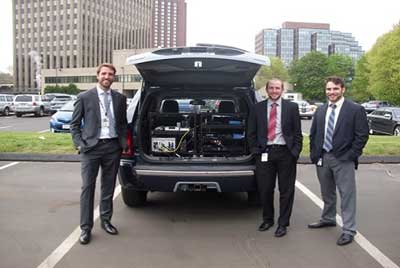 |
| FHWA delivered one of its instrumented vehicles to the Volpe Center in Cambridge, MA. |
Gregg Fleming (FHWA Center Director for Policy, Plan and Environment), Rick Marquis (FHWA Division Chief of Organizational Performance), and David Arthur (FHWA Division Chief of Energy Analysis and Sustainability) were briefed on the project during their visit.
Although data collection is focused on collecting car-following behavior in freeway work zones, the Volpe team plans to collect data during various road weather and operational conditions, such as rain and incident events. The Volpe Center is supporting this research through an interagency agreement with TFHRC.
For more information, contact Christopher Melson, 202-493-3271, christopher.melson@dot.gov.
FHWA Releases BAA for ATTRI Application Development
FHWA has released a Broad Agency Announcement (BAA) that calls for research will enable and expedite the development of revolutionary approaches, methodologies, and breakthroughs required to drive innovation and greatly improve the efficiency of independent mobility options for people with disabilities and provide greater accessible transportation choices for all travelers.
Under this BAA, which is written in support of the Accessible Transportation Technology Research Initiative (ATTRI), funds will be awarded for the development of applications in each of the ATTRI priority application areas through robust stakeholder outreach and user-needs assessment. Application areas include smart wayfinding and navigation systems; pre-trip concierge and virtualization; and safe intersection crossing.
ATTRI is a joint multimodal, multiagency USDOT initiative, co-led by FHWA and the Federal Transit Administration (FTA), with support from the Intelligent Transportation Systems Joint Program Office (ITS-JPO), National Institute on Disability, Independent Living and Rehabilitation Research (NIDILRR), and other Federal partners. The BAA is jointly funded by the ITS Joint Program Office and the Federal Transit Administration.
The objective of ATTRI is to advance technology applications that enhance accessible transportation and independent mobility choices for travelers with disabilities; and to improve opportunities for a seamless and complete trip that meets the diverse needs of travelers with mobility, vision, hearing and cognitive disabilities and provides them the ability to plan and execute an on-demand trip anytime of the day and from any location. ATTRI research focuses on the needs of three stakeholder groups: persons with disabilities, older adults, and veterans with disabilities.
Proposals are due by August 11, 2016. To view the announcement, visit https://www.fbo.gov/index?s=opportunity&mode=form&id=4f937d191f59cdccb30e8844684db9c0&tab=core&_cview=0.
For more information, contact Mohammed Yousuf, 202-493-3199, mohammed.yousuf@dot.gov.
ATTRI Collaborates with HHS and NIDILRR on Grant Opportunity
ATTRI recently collaborated on a grant opportunity with the Department of Health and Human Services’ (HHS) Administration for Community Living and the National Institute on Disability, Independent Living, and Rehabilitation Research (NIDILRR). Released on June 2, 2016, the grant opportunity— Disability and Rehabilitation Research Projects Program: Accessible Transportation—is focused on robotics and automation technology use in ensuring accessible transportation for people with disabilities.
The opportunity aims to advance the application of robotics and automation to enhance accessible transportation and improve opportunities for a seamless travel chain that meets the diverse needs of travelers with mobility, vision, hearing, and cognitive disabilities and enables them to plan and execute on-demand trips and associated services at any time and from any location.
Applications are due by August 1, 2016. To view this opportunity, visit www.grants.gov/web/grants/view-opportunity.html?oppId=284347.
For more information, contact Mohammed Yousuf, 202-493-3199, mohammed.yousuf@dot.gov.
SBIR-Funded Project Wins Best of ITS Award
A project made possible through USDOT’s Small Business Innovation Research (SBIR) Program recently won the Best of Intelligent Transportation Systems (ITS) Award at the ITS America Annual Meeting held at the McEnery Convention Center in San Jose, California.
Savari Networks, which was awarded a contract from FHWA (through the SBIR Program) for the project, won the award for developing a traffic signal interface application (app) for smartphones called SmartCross. The app can interface with traffic signal systems that control traffic lights and receive information about pedestrian signals.
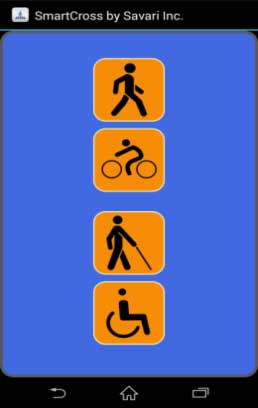 |
| SmartCross app |
According to Traffic Technology Today, which covered the Best of ITS Awards in a brief article, the technology “makes pedestrians and bicyclists active participants in the [vehicle-to-infrastructure] landscape, by connecting them to vehicles and traffic lights through their smartphones without the need for [dedicated short-range communication].”
The technology can send signals between the pedestrian’s phone and the nearest traffic signal box, notifying pedestrians when it is safe to step into the crosswalk. It also allows users to request pedestrian signals. For enhanced safety, the app provides audio, visual, and haptic (typically vibration) feedback to the user.
USDOT announces new topics each year through its solicitations, supporting projects like the SmartCross app to develop technological innovation using the highest level of expertise in the small business community.
For more information, contact James Pol, 202-493-3371, james.pol@dot.gov.
FHWA Publishes Report on Continuous Green T Intersections
FHWA recently published the report, “Safety Evaluation of Continuous Green T Intersections” (FHWA-HRT-16-036). The continuous green T (CGT) intersection is characterized by a channelized left-turn movement from the minor street approach onto the major street, along with a continuous through movement on the major street. The continuous through movement typically has a green through arrow indicator to inform drivers that they do not have to stop. The report documents research conducted as part of FHWA’s Evaluation of Low-Cost Safety Improvements Pooled Fund Study.
To overcome prior safety studies’ statistical challenges and improve product reliability, researchers used a propensity scores-potential outcomes framework to compare the safety performance of the CGT with conventional signalized T intersections using 30 treatment and 38 comparison sites from Florida and 16 treatment and 21 comparison sites from South Carolina. The benefit-cost analysis indicated that the CGT intersection is a cost-effective alternative to the traditional, signalized T intersection.
This report is intended for practicing engineers when contemplating application of CGT intersections and for researchers who wish to consider the propensity scores-potential outcomes framework in non-randomized, observational traffic safety evaluations.
The document is available to download at www.fhwa.dot.gov/publications/research/safety/16036/index.cfm.
For more information, contact Roya Amjadi, 202-493-3383, roya.amjadi@dot.gov.
Public Roads—May/June 2016
This issue includes: Celebrating a Double Anniversary; Leading the Charge for Safer Streets; Nailing the Cheats; A Sidekick for Rural Safety; Investing in Today and Tomorrow; and Hot Topic
It is available online via www.fhwa.dot.gov/publications/publicroads/16mayjun/index.cfm.
For more information, contact Lisa Shuler, Lisa.A.Shuler@dot.gov.
Innovator: Accelerating Innovation for the American Driving Experience—May/June 2016
This issue includes: Alabama's First Bridge Slide Exceeds Expectations; States Explore New Uses for 3D Models and Data; Diverging Diamond Interchanges Boost Safety Nationwide; Stakeholder Partnering; FHWA Incentives Help States Pursue Innovation; States Innovate!; and Events!
The issue is available online via www.fhwa.dot.gov/innovation/innovator/issue54/3dIssue/.
For more information, contact Melissa Yu at melissa.yu@dot.gov.
Turner-Fairbank Highway Research Center: www.fhwa.dot.gov/research/tfhrc/
Resource Center: www.fhwa.dot.gov/resourcecenter/
National Highway Institute: www.nhi.fhwa.dot.gov/home.aspx
Please forward this newsletter to others you think might find it interesting and/or useful.
Suggestions may be submitted to: FHWA_Now@fhwa.dot.gov